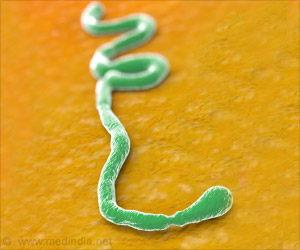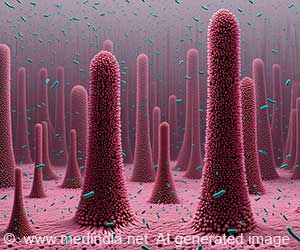Novel host mechanism that has evolved to limit the spread of Ebola virus infection with possible therapeutic implications is identified.
Highlights
- Ebola virus infection leads to a severe hemorrhagic fever and presently has no known treatment or vaccine.
- It involves interaction of viral matrix proteins with host cell proteins
- Host – virus protein interactions promote viral budding from the host cell and spreads infection to adjacent cells.
- New research has identified a new host-virus interaction that decreases budding and limits spread of infection.
Aim of Study
The study aimed to investigate interactions between host and viral proteins in Ebola and other viral infections, and how these interactions influenced budding of virus and spread of infection to neighboring cells. Prior studies have revealed that host – virus interactions act to promote viral budding and spread of infection.TOP INSIGHT
Host cell BAG3 (Bcl2-associated athanogene 3) protein could limit the spread of Ebola virus infection by decreasing the rate of virus budding.
Infections with Ebola as well and other viruses, such as Marburg, rabies and HIV, have shown interactions between viral matrix proteins such as Ebola VP40 with host proteins through short protein motifs such as the WW motif on the host cell protein and the PY motif on the viral protein.
Earlier studies have shown that these interactions promote viral budding and cause spread of infection within the host.
Details of Current Study
The research team screened for identifying new WW motifs in mammalian host cells that were capable of interacting with the corresponding PY motif of the Ebola Virus' VP40 protein. Not all viral PY motifs bind to every WW domain; the binding is specific, comparable to a lock and key.The screening threw up proteins that the research team had encountered in prior studies, but additionally they uncovered a new protein called Bcl2-associated athanogene 3 (BAG3), also referred to as chaperone protein, which normally acts to promote cell survival.
During their investigations, the research team employed virus-like particles produced by the virus's matrix protein, VP40, which are not infectious but precisely copy the budding step of infection.
Results of the Study
- On adding BAG3 protein to host cells expressing Ebola or Marburg viral VP40 protein, they found the rate of budding decreased in a dose-dependent manner
- Mutation of the WW domain of the host BAG3 protein preventing the virus-host interaction showed the levels of budding to remain unaltered.
- Reducing naturally occurring levels of BAG3 protein with synthetic strands of RNA increased the rate of budding.
How the BAG3 Protein Decreased Spread of Ebola Infection
Employing fluorescent labeled proteins and confocal microscopy, the research team found that the BAG3 protein sequestered VP40 in the host cell cytoplasm away from the cell membrane where it was critical for the viral particles to reach in order to be able to bud and spread to other cells.BAG3 is the first WW containing host protein found to negatively influence the rate of viral budding.
Scope of the Study
The findings of the study suggest that therapies that would increase the BAG3 –viral protein interaction, along with other treatments that might target other stages of the life cycle of the virus could give the immune system the much needed boost to ward off Ebola infection."We think we have uncovered a cellular defense mechanism against Ebola and other viruses by which the cell can counteract the virus' ability to bud and spread to other cells," Harty said.
"We want to dissect and understand this interaction further to potentially mimic the process for use as an antiviral strategy that could be used to treat these dangerous infections," added
Jingjing Liang, the lead author and a doctoral student at Guangxi University who had a fellowship at Penn Vet to work in the Harty Lab for two years.
Future Research Plans
- The group plans to conduct more studies using live Ebola and Marburg virus. However, they have already shown that BAG3 protein does reduce viral budding in a recombinant vesicular stomatitis virus that contains the Ebola PY motif.
- Dr Harty’s team plan to determine if BAG3 protein just sequesters the VP40 or affects it in other ways such as causing it to undergo alteration or degradation.
References:
- Jingjing Liang, Cari A. Sagum, Mark T. Bedford, Sachdev S. Sidhu, Marius Sudol, Ziying Han, Ronald N. Harty.Chaperone-Mediated Autophagy Protein BAG3 Negatively Regulates Ebola and Marburg VP40-Mediated Egress. PLOS Pathogens.(2017) http://dx.doi.org/10.1371/journal.ppat.1006132
Source-Medindia
 MEDINDIA
MEDINDIA





 Email
Email





